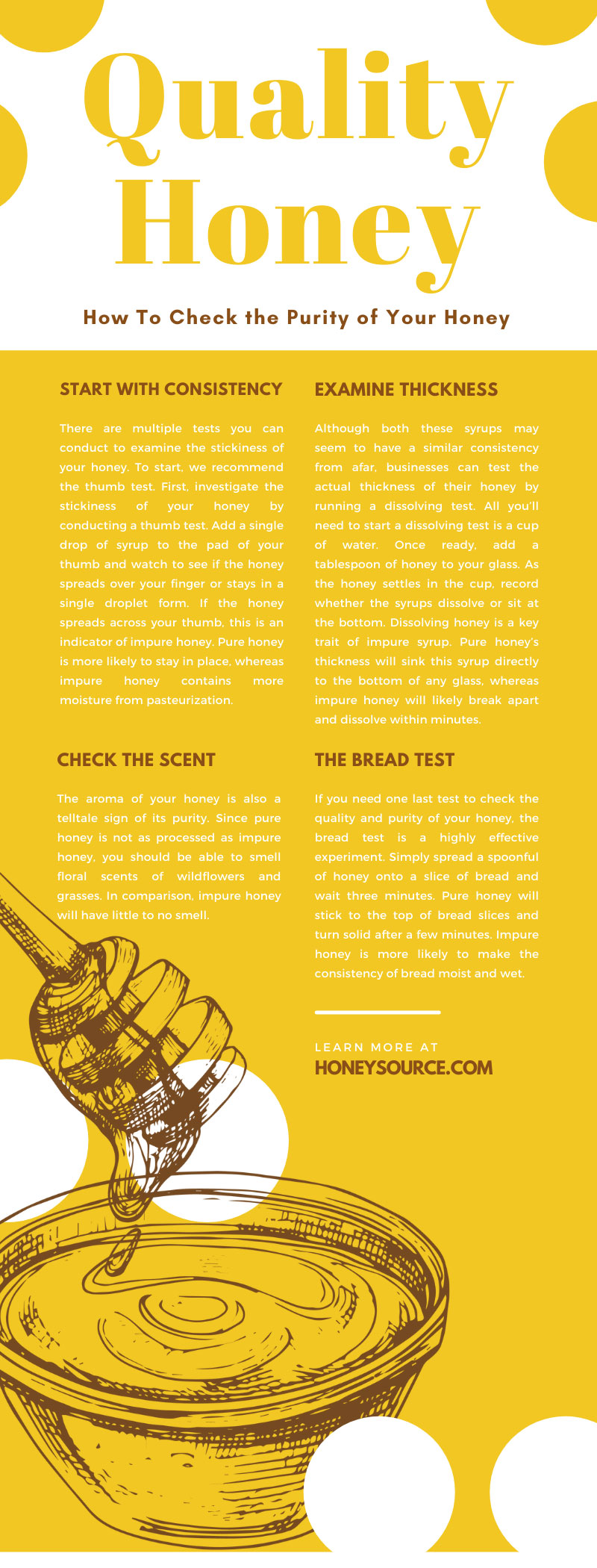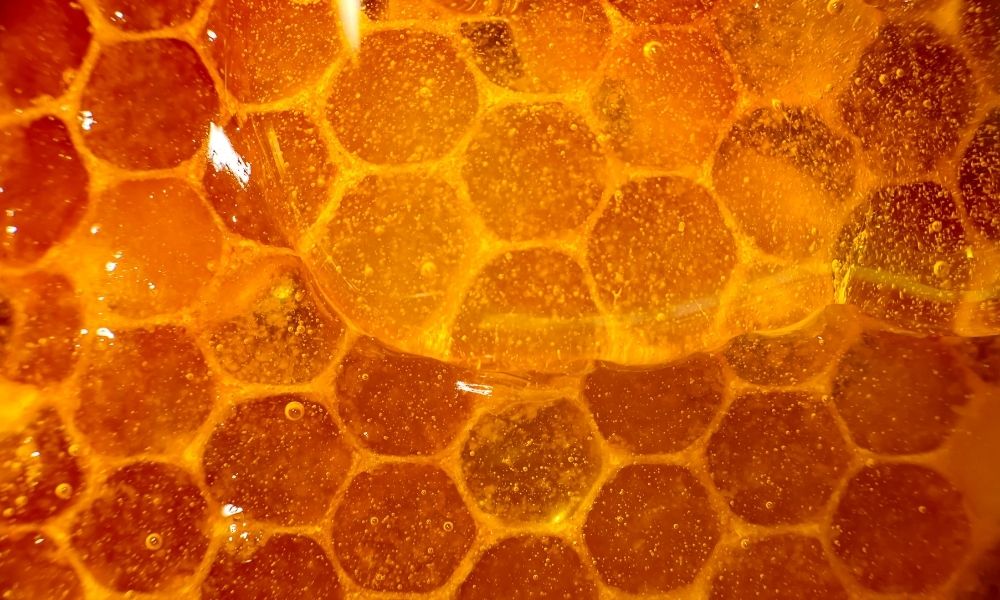When you invest in high-quality, 100 percent pure honey, you expect to receive a delicious and nutritious syrup. Businesses that use their honey in food recipes or health products must be even more vigilant over the purity of their honey orders. When honey is not pure or has a lower quality taste, this can affect an entire recipe or product.
Although most companies understand the importance of ordering high-quality and pure honey products, few businesses know how to test honey for purity. In this blog, we‘ll share our guide on how to check the purity of your honey.
Start With Consistency
One of the fastest ways to check your honey’s quality is to assess your syrup’s stickiness. There are multiple tests you can conduct to examine the stickiness of your honey. To start, we recommend the thumb test.
The Thumb Test
First, investigate the stickiness of your honey by conducting a thumb test. Add a single drop of syrup to the pad of your thumb and watch to see if the honey spreads over your finger or stays in a single droplet form.
If the Honey Spreads
If the honey spreads across your thumb, this is an indicator of lower honey quality. Pure honey is more likely to stay in place, whereas impure honey contains more moisture from pasteurization. The increased moisture content causes impure syrup to spread into a thinner, sticky texture.
While the thumb test is a reliable first test to try, this assessment is not 100 percent conclusive. We recommend testing your honey with several other tests to check its purity as well.
Examine Thickness
Impure honey and pure honey have two distinctly different textures and thicknesses. Pure syrup is considerably denser compared to impure syrup. Although both these syrups may seem to have a similar consistency from afar, businesses can test the actual thickness of their honey by running a dissolving test. Learn how to conduct the dissolving test below.
The Dissolving Test
All you’ll need to start a dissolving test is a cup of water. Once ready, add a tablespoon of honey to your glass. As the honey settles in the cup, record whether the syrups dissolve or sit at the bottom.
If the Honey Dissolves
Dissolving honey is a key trait of impure syrup. Pure honey’s thickness will sink this syrup directly to the bottom of any glass, whereas lower–quality honey will likely break apart and dissolve within minutes.
Similar to the thumb test, the dissolving test uses the added moisture in impure honey to make the differences between these two syrups more visible.
Taste Test
There’s no need to waste honey during your quality assurance test. In fact, conducting a taste test is a vital part of assessing the purity of honey. Here’s how to know whether the syrup you’re tasting is pure or impure.
If There’s a Sweet Aftertaste
Although a sweet aftertaste is delicious, it’s also a sign of impure honey. The lasting sweet flavor of honey is an added side effect of additional flavoring and sugars often added to impure honey formulas.
However, that’s not to say that pure honey lacks flavor. Pure honey is also incredibly sweet and delicious. Once swallowed, the taste of pure syrup is more likely to fade a minute or so after consumption.
Check the Scent
The aroma of your honey is also a telltale sign of its purity. Since pure honey is not as processed as impure honey, you should be able to smell floral scents of wildflowers and grasses.
In comparison, impure honey will have little to no smell. Sometimes flavoring and sweeteners can add a light scent to this syrup; however, you will not smell a pure floral aroma.
Look for Impurities
One of the easiest ways to check your honey’s quality is to conduct a visibility test. Simply pour a tablespoon of both syrups onto a plate and look for impurities. You should especially look for traces of pollen or darker-looking particles.
If You See Impurities
If you notice impurities in your honey, you’ve got 100 percent pure honey syrup filled with antioxidants, vitamins, and minerals. The impurities in this honey are visual proof that your syrup has not been processed and has all of its potent health benefits intact.
If there isn’t a single sign of impurity, you’re most likely looking at impure honey. This is because manufacturers often remove particles, such as pollen and bee saliva, during pasteurization.
Pair It With Heat
Heat causes pure and impure honey to have two very different chemical reactions. So, if you’re still unsure about the quality of your syrup, we recommend trying out the flame test.
The Flame Test
For this test, you’ll need a matchstick. Start by dipping your match fully into your jar of honey. Next, you’ll try lighting your matchstick to see how quickly it’s able to light up.
If Your Match Doesn’t Light at First
Matchsticks with impure honey will take longer to light. This is because the added moisture in impure honey’s formula makes it more challenging to produce a flame. Pure honey will instead light up immediately with no delay.
The Bread Test
If you need one last test to check the quality and purity of your honey, the bread test is a highly effective experiment. Simply spread a spoonful of honey onto a slice of bread and wait three minutes. Once three minutes have passed, you’ll check to see whether your bread is solid or wet.
If the Bread Is Solid
Pure honey will stick to the top of bread slices and turn solid after a few minutes. Impure honey is more likely to make the consistency of bread moist and wet.
While the consistency will differ, both these syrups will be a delicious toast topping.
We hope our guide on how to test honey for purity has helped your business feel more confident using 100 percent pure honey products. Here at Honey Source, we supply companies with the best and purest bulk organic, raw, unfiltered honey available. Check out our website to learn more about our pure honey, raw honey, or other honey products.


